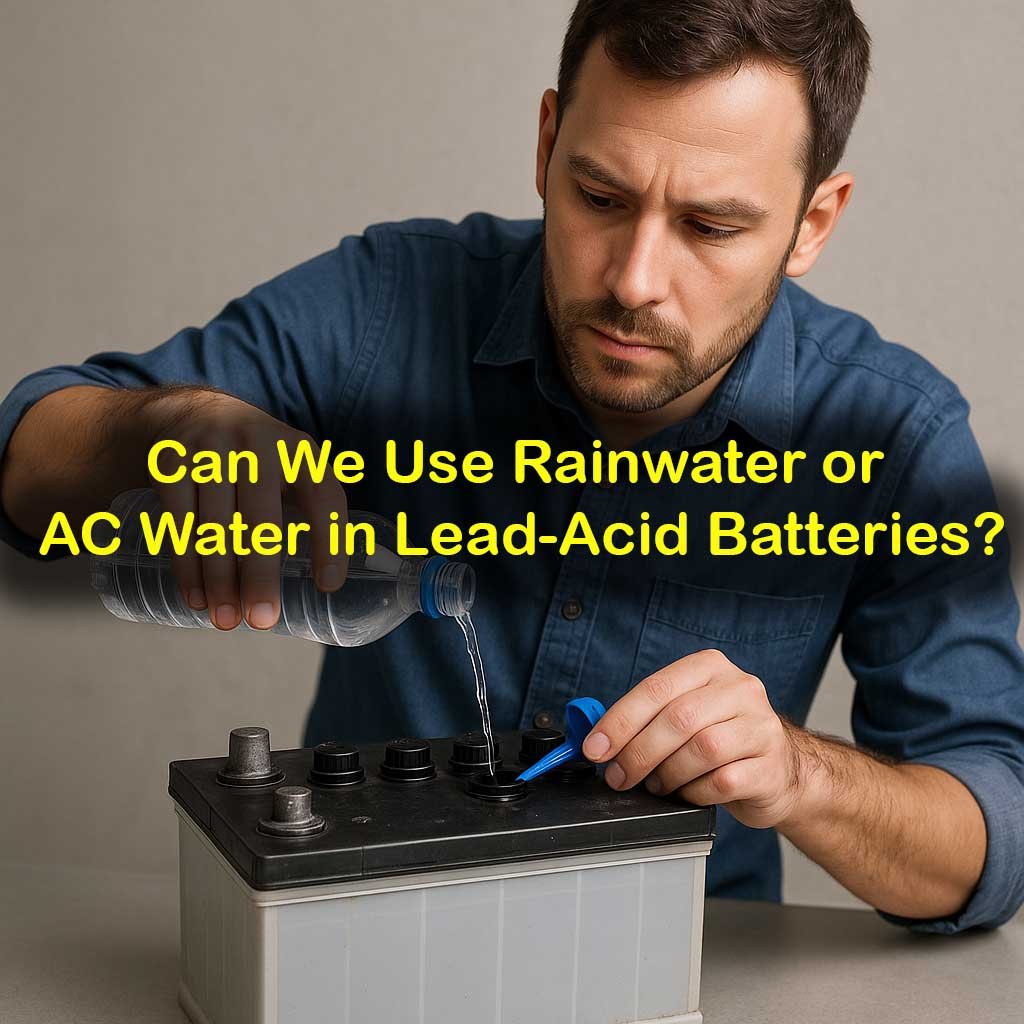The Complete Guide to Safe Water for Battery Maintenance
Lead-acid batteries are a trusted choice for cars, solar systems, and home inverters. But one of the most overlooked aspects of battery maintenance is the type of water you use to top them up.
In this post, we’ll explore what water is safe for lead-acid batteries, whether you can use rainwater or AC water, and how to make distilled water at home—all using simple, beginner-friendly language.
What Type of Water Is Used in Lead-Acid Batteries?
Only distilled water is recommended for topping up lead-acid batteries. It’s 100% free of minerals, salts, and contaminants.
Other water types—like tap water, mineral water, or filtered water—may contain dissolved ions and metals that can damage your battery’s internal chemistry, shorten its lifespan, and even cause internal corrosion.
Can we use tap water in inverter battery?
➤ No. Use only distilled water for best results.
Can You Use Rainwater in Batteries?
Rainwater seems pure and natural—but it’s not the same as distilled water. While it has fewer minerals than tap water, it often contains dust, dirt, and airborne pollutants.
If you’re wondering:
Can we use rain water in inverter battery?
➤ Not recommended unless it’s been boiled and filtered properly.
If absolutely necessary, rainwater must be:
- Boiled for at least 10–15 minutes
- Filtered through activated carbon or UV-treated
- Stored in a clean, sealed container
Is Air Conditioner Water Safe for Batteries?
A common question is:
Can we use AC water in lead acid battery?
Air conditioners produce condensate that’s low in minerals, but it may still contain mold spores, metal particles (from coils), or bacteria. This makes it unreliable for battery use—unless distilled properly.
Avoid using AC water unless it’s passed through a home distillation system.
Can You Make Distilled Water at Home?
Yes! You can prepare DIY distilled water at home using the following method:
Simple Distilled Water Method:
- Take a large pot and fill it halfway with tap water.
- Place a heat-safe bowl inside the pot (it should float).
- Cover the pot with an inverted lid.
- Boil the water—steam will rise and condense on the lid, dripping into the bowl.
This method removes salts, bacteria, and impurities, making the water safe for battery use.
How to make distilled water for battery at home
Use the condensation technique described above.
What About Iodized or Purified Drinking Water?
Many people confuse iodized or RO (reverse osmosis) water with distilled water.
- Iodized water is for human consumption—not for chemical-sensitive systems like batteries.
- RO water still contains some ions and may not be fully safe.
- Only distilled water guarantees zero contamination.
Extra Battery Maintenance Tips
✅ Use only plastic funnels—metal funnels can corrode or introduce particles.
✅ Always check battery water after charging, not before.
✅ Maintain water level just above the lead plates—not overfilled.
✅ Avoid storing water in open containers that can catch dust.
Important Precautions:
Here are important precautions to follow when dealing with lead-acid battery water to ensure safety, performance, and longevity of the battery:
1. Always Use Distilled Water
Only use distilled or demineralized water for topping up lead-acid batteries. Tap water, rainwater, or air conditioner water can contain minerals, salts, or impurities that cause:
- Sulfation of plates
- Internal short circuits
- Reduced battery life
2. Check Water Levels Regularly
Check the electrolyte levels at least once a month or more frequently in hot climates or under heavy usage. Low electrolyte can expose the battery plates and cause irreversible damage.
3. Never Overfill the Battery
Overfilling can cause the electrolyte to spill during charging, leading to:
- Corrosion of battery terminals
- Acid leaks damaging nearby equipment
- Loss of active material
Fill only up to the recommended level mark, usually just above the top of the plates.
4. Add Water Only After Charging
Always charge the battery first, then check the water level and top up if needed. Charging causes the electrolyte to expand; topping up before charging may cause overflow.
5. Use Protective Gear
Battery electrolyte contains sulfuric acid, which is corrosive. Always wear:
- Rubber gloves
- Safety goggles
- Old clothing or apron
Accidental contact can cause skin burns or eye injury.
6. Ensure Good Ventilation
Charge or maintain lead-acid batteries in a well-ventilated area. They emit hydrogen gas during charging, which is:
- Highly flammable
- Explosive in enclosed spaces
Avoid open flames or sparks nearby.
7. Keep Battery Terminals Clean
Corrosion on terminals can affect performance. Clean terminals with:
- A brush and baking soda solution
- Petroleum jelly to coat after cleaning (to prevent further corrosion)
8. Follow Manufacturer Guidelines
Always refer to your battery’s user manual for:
- Recommended water type
- Maintenance schedule
- Safety instructions
Conclusion: What Water Is Best for Lead-Acid Batteries?
To extend battery life and get consistent performance:
- Stick with distilled water only
- Avoid using rainwater, AC water, or tap water unless treated
- Never use iodized or mineral water
If you want your battery to last 3–5 years without issue, following these water-related tips is one of the easiest and most effective steps.
Related Questions (for SEO boost)
- Can I use rainwater in inverter batteries?
- Is AC water distilled water?
- Can we make battery water at home?
- Is boiled water the same as distilled water?

